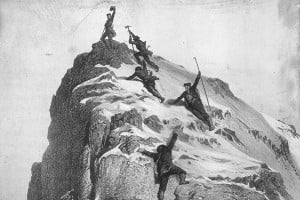
Tom Livingstone recalls his attempts to make the first free ascent of the Voie des Guides on the Petit Dru above Chamonix, and reflects on playing a 'pointless game' of alpinism with arbitrary rules and lucky chance...
The Aiguille du Dru is the most impressive mountain in the Chamonix valley—to my eyes, at least. The spear-shaped peak is so sharp it cuts at the sky, like a rocket ready to launch. The Voie des Guides quests up the Petit Dru's dark north face, forging a direct line to the 3733-metre summit. The Guides Route packs a punch and is rarely climbed. Despite modern tools, techniques and attitudes, by the start of 2022 it still hadn't been freed.
Yannick Seigneur said after the first ascent: 'In the past, it was an impossible mountain… All the routes were and will remain steps forward in the history of mountaineering.'
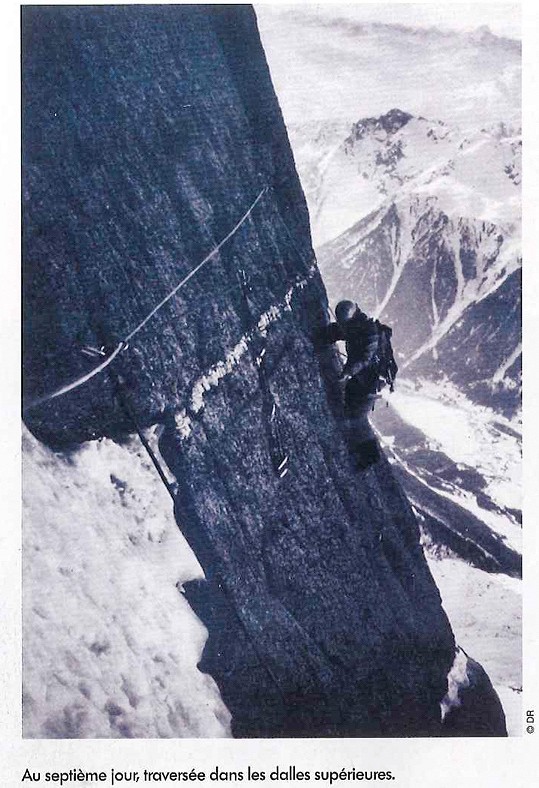
***
Once, I gazed up at the dark faces in the Alps and wondered if I could take the challenge and style of British trad climbing to these bigger walls. And once I started to wonder, I went into the mountains to play…
In the Mont Blanc massif (and perhaps the Alps), there are few major first ascents up for grabs. Instead, my partners and I add difficulty or an extra challenge to existing routes: we 'play a game' with our alpine climbing, creating arbitrary rules to make it more interesting. For example, we try to free-climb an existing hard aid route in the mountains, link several routes together, or continue without stopping to bivy.
A few years ago I moved to France; my home is now a few kilometres from Mont Blanc. This mentality, this style of climbing 'free,' is nothing new. But things were different for pioneers of the past.
For over one hundred years, brave and highly-skilled climbers ascended mountains by any means, often using aid (also known as 'artificial' means). There were very few conditions or rules: you tried to reach the summit by whatever self-powered means you chose. With pitons and hammer, bold men and women ascended giant faces using only basic protection and rudimentary equipment.
I can't begin to imagine what it was like to start from Chamonix town centre in 1967 and make the first moves up the north face of the Aiguille du Dru, like Yannick Seigneur, Michel Feuillerade, Jean-Paul Paris and Claude Jager did when they established the Voie des Guides. Their comments were emotive: 'The Dru! The name evokes such fights!'
I believe climbing is—in part—a game. In his seminal essay 'Games Climbers Play,' Lito Tejeda-Flores writes: 'The decision to start playing is just as gratuitous and unnecessary as the decision to start a game of chess. In fact, it is precisely because there is no necessity to climb that we can describe climbing as a game activity.'
However, the seriousness and commitment of climbing make it 'for keeps.' We can't just stop and go home from halfway up a mountain, and these real consequences make the game much more interesting. Alpinism has very few 'rules' because the mountain conditions, weather and environment already make it difficult.
Although Tejeda-Flores said, 'the rules of this game do not require one to push all leads free,' I believe we are now in a new era; an ascent is only fully recognised by our community if climbed free. But does climbing mean anything, though? Does it mean anything to do the first ascent, first free ascent, or the tenth? No, it's meaningless—but fun.
Climbing is also rewarding. I appreciate journeying through beautiful, jagged peaks, the effort of movement up steep, solid stone and sharing rich adventures with friends. Sometimes I look for a high-quality first ascent or significant repeat. But everything is changing: the Alps are warmer and drier due to climate change. Mixed climbing is the norm in winter, even if a pitch has little ice, yet logically it's still climbed with axes and crampons. With mountains cluttered by routes and the ice melting fast, how do I continue playing?
One answer lies in trying to free alpine routes which have sections of aid. This adds a few rules to our game of alpinism: you cannot use the gear to ascend, only as protection. If you fall you must lower back to the belay, pull the ropes and start again.
This style (free climbing, ideally onsight) is both mentally and physically engaging. Nothing concentrates the mind and body like staring at your pick, balancing on a centimetre edge as you teeter upwards…
Free climbing also adds pointless ethics and the opportunity to give harsh-but-fair grades, which I like. I think the onsight is the most highly prized, and an ascent is incomplete if you pull—or rest—on the gear. I've even heard some climbers say, 'top roping is basically cheating.'
***
I imagine it was all a game to the original pioneers on the Voie des Guides, too—otherwise the seriousness of alpinism might have been overwhelming. How else could you approach a vertiginous, dark wall of granite in the 1960s? The leader did not risk a fall. To step onto these faces was like beginning a labyrinth without the certainty of finding the end.
In 2012, Jeff Mercier attempted the Voie des Guides with Korra Pesce. It was Jeff's second try at the line, and the super-strong pair made an impressive 'single day' push. With icy conditions, they climbed long, steep pitches of mixed climbing and dry tooling. They followed giant corners holding only a thin ribbon of ice, and delicate slabs. Unfortunately the pair got off-route above the Niche and were helicoptered from the face that night.
Somehow I became aware of the Voie des Guides and the remaining challenge. But if Jeff and Korra, and later the impressive Groupe Militaire de Haute Montagne (GMHM) didn't free the route, what chance did I have?
***
Twice I stood beneath the Dru's towering north face and tried to climb the Voie des Guides. Twice I was too optimistic, my belief in the forecast or will-power misplaced. Twice we bailed.
In January 2022, Rob Smith and I pitched our tent in the snow below the Dru and jumped inside. Rob is American but now lives in Chamonix, with more classic, motivating or hilarious quotes than I can ever remember. On a recent mixed-climbing day Rob shouted: 'Dude, you have to make peace with the fact you might cannonball outta there!'
As the faint winter sun dived into the horizon, the temperatures plummeted. Tell-tale streaks of dark cloud whipped over the summits around us, and the wind began to howl…
That night I worried the tent poles might snap. We killed the 4 a.m. alarm and pulled the sleeping bag tighter. I'd checked the forecast, but my optimism over-ruled reality. The predicted temperatures went from -21c to -13c and the winds from 16kph to 60kph, but I'd only seen the numbers I wanted. Now I regretted my enthusiasm, in cutting cold and pouring spindrift. These conditions were too savage (even for January) for technical climbing; we'd likely get frostbite.
We decided, sensibly, to climb only the first quarter of the route. We'd stay warmer, and although I've climbed three other routes on Les Drus, the Voie des Guides isn't obvious. Learning the first section would be beneficial for when better weather allowed another attempt. 'Shit,' I said as we stepped out of the tent. I intended to keep my fingers and toes.
"Well dude… it was kinda forecast," Rob replied, ever patient.
The air was biting, blowing in a crisp cold which pinched bare skin. Rob and I took quite a beating, shivering up the pitches. We climbed in all our clothes and I often looked down to see Rob furiously swinging his limbs. "It's worse than Alaska!" he chuckled.
Happily, the climbing was really enjoyable, flowing up solid crack systems. We reached the base of the first crux pitch: an overhanging thin fissure which punched through a band of steep, grey granite. It was given '*** M8' on the GMHM topo. Rob and I turned tail, but as we staggered the final steps to the tent, I wanted a rematch. Persistence and a short-term memory are a dangerous combination, but occasionally they're helpful in climbing. I forgot the suffering…
***
…On my second attempt, in early March, I climbed with Matt Glenn. Others had nicknamed the solid northern-Irishman, 'Big Mat,' like the local hardware store.
Last year I'd made the first free (and second overall) ascent of Vol du Dragon with him. This intriguing route on the north face of Les Droites had solidified our partnership, and the adventure was stereotypical of our alpine games.
Matt and I also spend a lot of time laughing, creating ridiculous stories out of a single sentence, pulling a thread of nonsense. Beneath the Dru we joked about the rocket-shaped peak and surfing it to the moon.
Unfortunately, I still hadn't learned my lessons: my interpretation of the forecast was wrong again. Matt and I also took a beating, our water bottles freezing solid.
We retraced the pitches I'd climbed with Rob and this time I led the '*** M8' pitch. I torqued my axe heads in the crack and used small-but-positive footholds to press my body to the side, my limbs tight to maintain the tension. I plugged in excellent cams, managing the pump in my arms and calves.
The crack widened into a pod, footholds became small granite edges and suddenly I was fighting hard. 'Watch us here!' was all I could shout to Matt, rather than saying something cool about the climbing. The tagline on my harness hung into space, twitching every time I moved. Finally, I flopped onto the belay ledge, relieved to onsight this first crux.
The daylight faded a few pitches higher. 'Why am I so optimistic?' I wondered. Matt thought the same, occasionally screaming—jokingly—into the wind: "Fuck you and your enthusiasm!" We laughed into our down jackets. "Man, I'm gassed," Matt said. That was it; we bailed just below the Niche. I began to wonder how much fun I was having in playing this game.
***
Mid-March. 'Third time lucky…?' I thought as Tom Seccombe and I pitched the tent in exactly the same spot beneath the Dru. I'd finally waited for warmer weather and lighter winds for this attempt… or so I thought.
I glanced at Tom; his head sprouted a mass of giant ginger dreadlocks. He twisted a thick cable of hair through his fingers when deep in thought—which was most of the time. Quiet and headstrong, Tom wasn't too bothered by the topo. "Ok," he shrugged and smiled.
The following morning we launched up the Voie des Guides. We followed the same pitches as my previous two attempts: through the steep chimney, tip-toe up the slab, and then I cleanly re-led the first crux pitch again. At the belay I chuckled at my stubbornness (or was it determination?) in re-climbing these pitches. Is it really necessary for me to be here? I thought. Am I just playing, in my own way? Regardless, I'm going sunny rock climbing after this!
Tom and I quested beyond my previous high point and into the Niche as the granite was painted a delicious gold. The Niche was once a hanging icefield in the middle of the north face, concave like the Dru's cavernous heart. Now, unfortunately, it's a shrivelled strip of ice pockmarked by rocks. Tom and I chopped a small ledge and slumped into the double sleeping bag. All night I watched, hypnotised, as the alien-like headlights of the piste machines slowly waved across the mountainside opposite.
In the grey morning we creaked awake and soon were climbing steep, oppressive corners above the Niche. I took over the lead, the packs hanging in space and seemingly making themselves heavy as I hauled them, but I didn't care—I was simply happy to be playing in the mountains.
Around noon, light snow began to fall, glittering in the sunlight high above me. The air was crystal. Fat flakes pattered onto my hood and I sighed: the weather was going to shit. Now we'd have to get off this thing as fast as possible, sacrificing the free ascent. Suddenly I didn't care about anything; I just wanted 'out.' But this is climbing, not chess…
***
Tom found the famous Quartz Vein pitch and pendulumed across it. Seconding, I thought, 'I'll just pull on the gear when it gets hard.' But I kept finding solid hooks and absorbed in the act of solving this vertical puzzle. Snow hid the footholds and my crampons skittered, but at the belay the flurry moved down the valley and my body was warm. My fire was back; since I'd climbed free so far, why not keep trying? "Let's have it!" I shouted.
The final crux pitch was above: another 'mythical corner,' given '*** M8+?' I launched upwards until blocked by a two-metre overhang and baggy hooks. Plugging in good gear, shaking out and delayed the inevitable. Finally, I shouted "Here goes!" to Tom, filled my lungs, and attacked the roof.
It's rare to climb with such intent and purpose, almost without fear of falling. I completely wanted to free this pitch, and with each hook I found, I tested, shouted, and pulled. It was a simple desire to attack. My crampons skated as I desperately tried to oppose the torqued axes, and I had little energy beyond stuffing in cams and continuing.
50 metres above Tom, I made a belay with my remaining few pieces of gear. I'd given my all, and only just succeeded. A torque could've blown at any time, as I kicked my feet higher and lay-backed, but luck had been on my side. Why me? I wondered. I'm not stronger or more talented than anyone else; I guess I'm just psyched and lucky.
Later, in darkness, I'd already started shifting rocks around a ledge when Tom arrived. The bivy was marginal but the best I could find. I kicked a few stones too close to the edge and they tumbled down for 800 metres. "Not bad," Tom said. Half the tent hung in space but we were too tired to care.
I unzipped the tent in the morning; the outside world had been oddly hushed. "Shit," I said, rubbing my blurry eyes. "Bad luck!" 10 centimetres of snow coated everything; the mountain now resembled Scottish mixed climbing. We hungrily sucked Werther's Originals and drank hot water with electrolyte tablets. "I'm so fucked," Tom said. "I haven't been this tired in a long time!"
I can't remember if Tom volunteered to lead first, or if I encouraged him. The 'breakfast' M6+ pitch above the bivy had looked pretty steady in the glow of our headtorches last night, but was now caked in snow.
Tom racked up and, gaining energy, soon reached the belay. But perhaps I should've insisted that I lead this pitch—the last moderately tricky one before the top. I suppose the very purest style for my free ascent would ideally be to lead every single pitch on the route, but I was happy to lead all the cruxes.
I doubt I could find a partner motivated to only second the route; it also wouldn't be much fun for them. Besides, I like to share adventures, and this is alpinism, not El Capitan (where you have all day and each member can have many attempts to redpoint a pitch). We lead when it's our turn or when we happen to be in the position, and although I wanted the crux pitches I wasn't too obsessed about the others. We're just playing, after all.
I freed this pitch and soon, finally, eventually, Tom and I were high-fiving on the summit of the Petit Dru. "Woohoo!" I said, hungry and happy. So often, technical climbing (in any discipline) comes down to subtle chances: a crucial foothold spotted at the last second or a power-scream of fear and adrenaline.
We had played our pointless game in the mountains, adding the rule of 'free,' and this time we had come away content. Back in the valley, there would be no change, meaning, or recognition. But for now, we were just satisfied to be playing up here amongst the sun and clouds.
Three times, I tried to climb the Voie des Guides. Twice I was too optimistic and we slid down our ropes, bailing back to the ground. But once, with a lot of luck, we played the game - and felt like we had won.
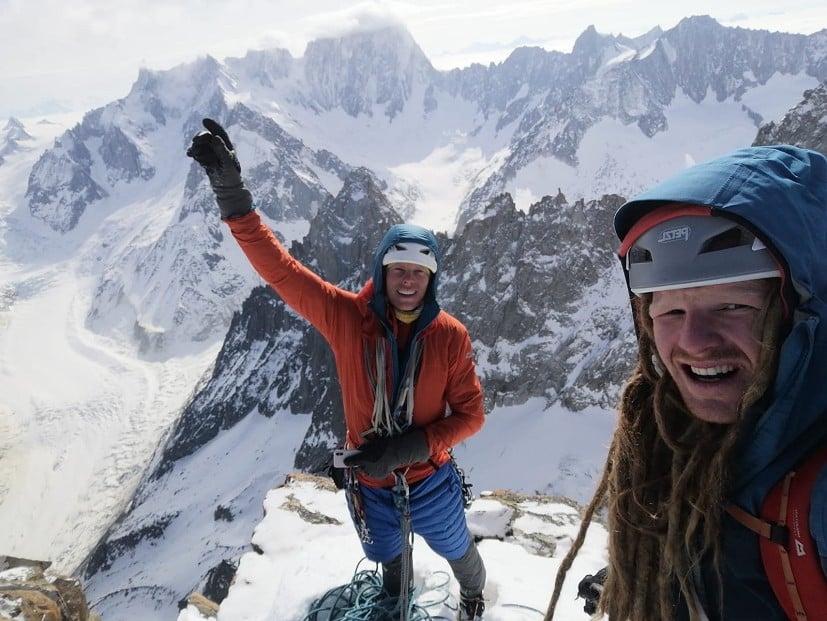
Voie des Guides, north face of Petit Dru, Mont Blanc massif
10-12 March 2022
Tom Livingstone (free) and Tom Seccombe.
First Free Ascent. 850 metres. M7+. ***
GMHM Topo here
Kendal Mountain Festival 2022
The social event of the year for outdoor people takes place across the town from 18th-21st November.
The High Mountain Session: Risk vs Reward in Alpinism presented by Mountain Equipment
Tom Livingstone will be speaking in this brand new session, presented by Mountain Equipment, looking at why many climbers and mountaineers are drawn to high risk and how we can learn to manage the dangers faced in adventure sport.
- Book tickets and passes on the KENDAL MOUNTAIN FESTIVAL SITE
- ARTICLE: The Great Game - First Ascents in Pakistan 3 Dec, 2019
- ARTICLE: Tom Livingstone - Style Matters 20 Sep, 2018
- ARTICLE: A Tribute to Marc-André Leclerc 21 Mar, 2018
- ARTICLE: Tom Livingstone on Finding Peace 21 Aug, 2016
- A Recipe for The 4th Dimension (E7 6c) 24 Aug, 2015

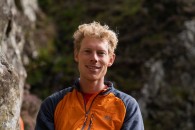

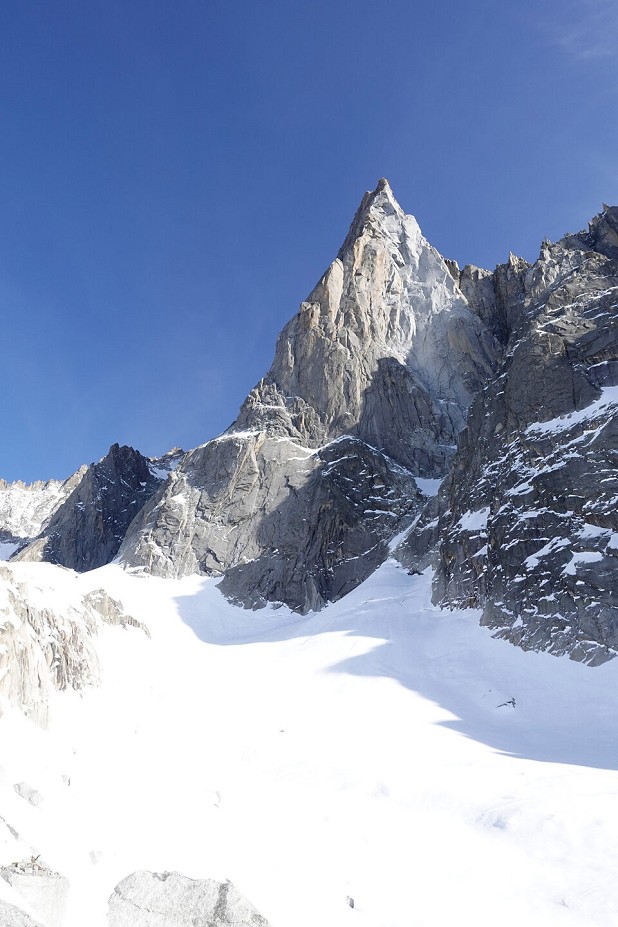
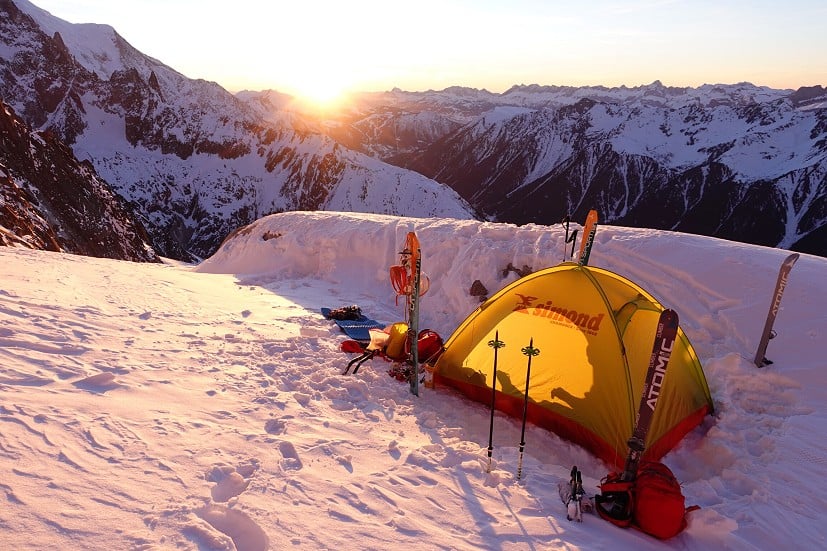

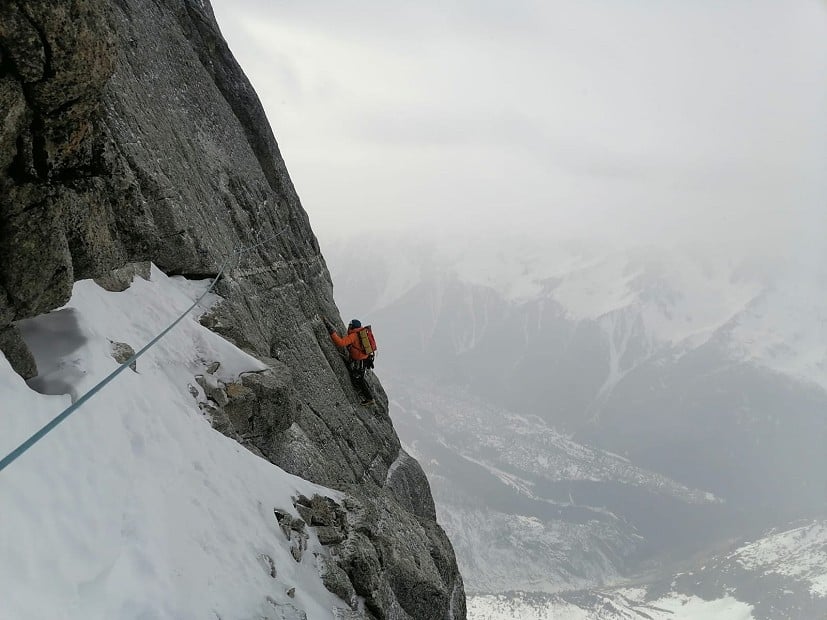
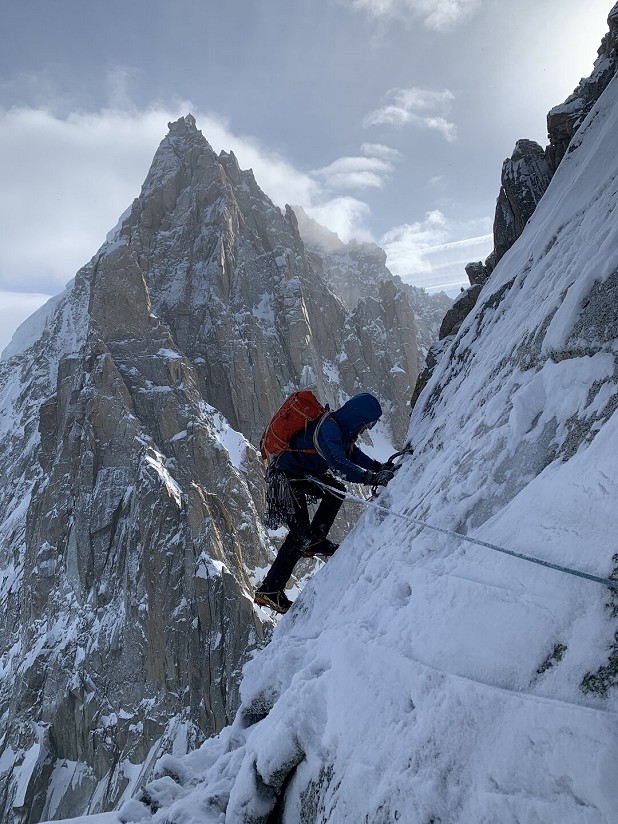
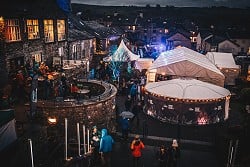
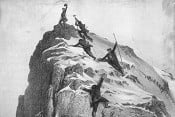
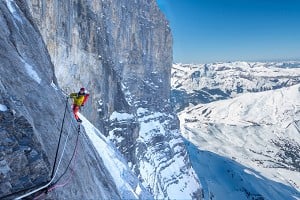

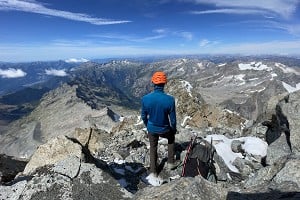
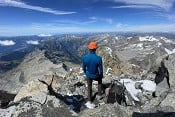








Comments
Great read, this bit in particular was quite evocative
Strong dreadlock scenes...
I think that title image needs a bit of an edit!
Really enjoyed reading that. To go with the FA ascent photo and Tom's photo, here is my photo of Jerry Gore on the traverse during a three day (non-free!) summer ascent in 1988. Also a photo of me sporting Ron Hills above the then less shrunken niche. All we had to go on was the FA description from the AC guidebook and a rumour that a major rockfall had affected the route above the niche (it hadn't).
Great read. Would be even better to heard about the decent too, afterall, they're only halfway through the adventure once they've reached the summit! Did they decend the same way they came up? Is it even feasible to do that given their tagline and haul bags had been hanging in the abyss on the ascent? Did they have to bivvi again? Is there an easier route back down?